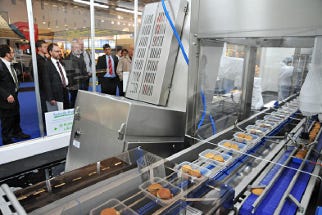Convenience continues to be a focal point for food packaging
March 11, 2015
Editor's note: This food trends article is courtesy of the folks at Anuga FoodTec, the international trade fair for food and drink technology, scheduled for March 27-30, 2012, in Cologne, Germany.

Anuga FoodTec
Zurich-style veal fricassee in cream sauce in five minutes, fresh fruit salad without time-consuming cutting and slicing, crispy rolls for warming in the oven—fast preparation and ease of use offer so many tempting advantages that more and more people are buying convenience products. Demand for these food products will continue to rise in the coming years because shopping habits are changing, and a growing number of people are making spontaneous purchases instead of stocking up on groceries in advance.
Modified-atmosphere packaging (MAP) is a process that makes many convenience products possible, especially baked goods, cheese, sausage and fresh meat, many ready-meals, sandwiches and fruit salad. Packaging food products under modified atmosphere conditions or protective gas is a process that has been in use for many years now in various segments of industrial food production. Depending on the gas mixture used, the shelf life of pressure-sensitive food products can be lengthened, for example, and the bright red colour of beef and pork can be preserved longer. As a rule, the protective gas is a mixture of oxygen, carbon dioxide and nitrogen.
Individually tailored to the product
The process works like this: During the packaging process the air is suctioned out of the package, which is then filled with the protective gas. Under normal conditions, this minimizes the residual oxygen content in the package and in the product. The protective gas can be a single gas or a combination of various gases. Protective gases or protective gas mixtures are individually tailored to the food product to be packaged. And there are also processes in which the gas mixture contains a higher proportion of oxygen than the air we breathe. These protective gases are used above all in the packaging of beef and pork.
MAP packages can be produced using either thermoforming machines or tray sealers. Thermoforming machines use rolls of plastic film, which can be refilled inline. They are very efficient, operating at a high cycle time and with very little wastage of film. The rolls of packaging film can be stored without problems. Tray sealers, on the other hand, work with prefabricated trays.
Products with not only longer shelf life, but also more visual appeal MAP packages are intended to not only ensure longer product shelf life, however; they also are designed to be environmentally friendly, practical and convenient. At Anuga FoodTec many companies will present their latest developments in terms of consumer friendly solutions that also ensure visual appeal to customers at the point of sale. In many cases, for example, clever little technical features in the package make it easier to handle ready-meals. The company ES-Plastic of Passau, Germany, for example, offers two-compartment PP trays for pasta dishes with a perforation. After heating in the microwave, the speedy cook can pour the sauce over the noodles, easily and without dripping.
Another example is a polypropylene tray that holds four small skewers with meat, vegetables or fruit. The skewers seem to float in the tray. This type of presentation is made possible by two small side compartments, each featuring four indentations. The skewers are anchored by clicking them quickly and securely into slots, where they present an appetizing appearance.
In demand: Packages that open without implements
Easy opening without having to use implements such as scissors or knives is also increasingly in demand in the area of MAP packaging for fresh meat. Here the peel-back cover foil must manage a balancing act between an absolutely hermetically sealed closure, even in the event of contamination at the seal edges, and an easy to open solution. This is necessary to ensure a high degree of food product safety, which reliably prevents oxygen from penetrating into the package. With a new cover foil, the German company Südpack Verpackungen offers just such a solution for easy opening of fresh meat trays. Developed in cooperation with the manufacturers Sealpac and ES-Plastic especially for tray sealer applications, the foil is an alternative to PP-single-compartment trays with tightly sealing foil, which can't be opened without using an implement.
Fewer germs, greater safety
The packaging machine manufacturer Multivac has presented a new process for high-pressure processing of food products. Until now, the main reason that high-pressure processing of food products in protective gas has been almost impossible is that the packaging materials were often damaged as a result of the processing. With multi-layered packaging materials, for example, undesirable delamination of individual layers occurred; and the foils would break where bent or become deformed. Even micro-defects can diminish the effectiveness of a packaging material's barrier function, which means oxygen can penetrate into the package. That is why only vacuum-packed food products have been processed under high pressure until now as a rule.
Now Multivac has improved the HPP (High Pressure Processing) process in collaboration with the company Uhde High Pressure Technologies: Regulated build-up and release of pressure in an autoclave and appropriate MAP packaging concepts are used to prevent damage to the materials.
High-pressure processing of packaged food is considered worldwide to be one of the most promising technologies for reducing harmful germs on meat and poultry, ready-meals and other food products. This type of processing makes it possible to increase the shelf life and safety of food products without using heat or preservatives, which has advantages for food producers and consumers. The original nutritional value and flavor of the foods is almost completely retained.
Source: Anuga FoodTec
.
About the Author(s)
You May Also Like


